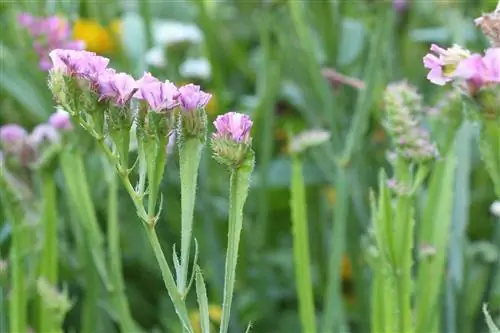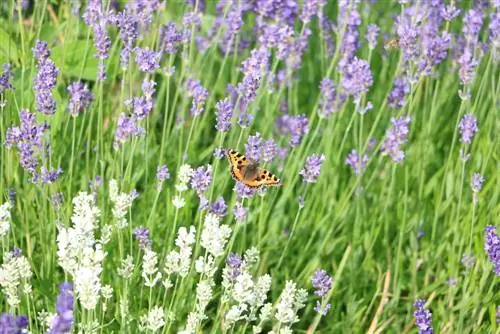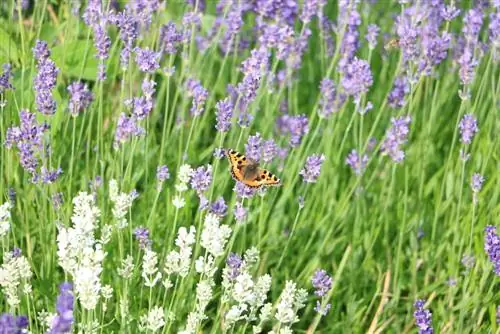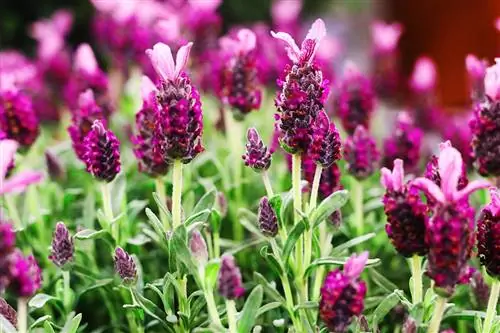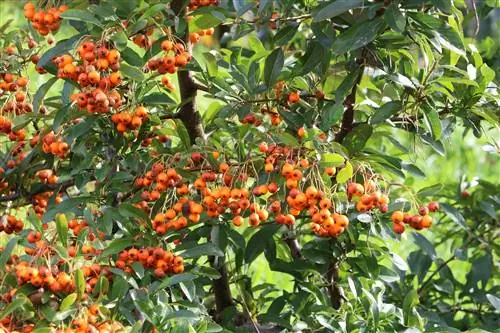- Author admin [email protected].
- Public 2023-12-17 03:39.
- Last modified 2025-06-01 06:48.
There are plenty of them, the sunny corners and lean spots in the garden, predestined for sea lavender. Bright sunshine causes no problems for the decorative flowering shrub, nor does barren, dry soil. It is therefore considered a popular gap-filler among hobby gardeners in problematic locations. In the pot, Limonium also creates charming accents without demanding constant attention. The pretty coastal plant also provides colorful material for airy, light dry bouquets. The following instructions for plants and care contain all the important factors for successful cultivation.
Profile
- Plant family: Plumbaginaceae (Plumbaginaceae)
- Genus: Sea lavender (Limonium)
- Perennial, herbaceous flowering perennial
- Predominantly found on the coasts of the Mediterranean and Atlantic
- Growth height from 10 to 70 cm
- 350 species with white, lavender, yellow flowers
- Flowering period from June to September/October
- Common name: sea lavender
Recommended location conditions
Sea lavender is extremely ascetic. His requirements for the location are therefore reduced to a few criteria:
- sunny to semi-shady location with at least 6 hours of sunshine daily
- dry, sandy soil, preferably calcareous
- deep, permeable soil
The robust constitution of all Limonium species allows them to settle in windy places as long as there are sufficiently bright lighting conditions.
Plants in the bed
For early young plants, the planting season begins in May. At the intended planting site, the soil is thoroughly weeded and loosened so that the taproots quickly gain a foothold. The planting pit is about twice as large as the root ball. If it comes out of its container very compacted, pull it apart a little with both hands. Before the sea lavender is placed in the ground, drainage made of gravel or grit at the bottom of the pit prevents the formation of waterlogging. Plant Limonium so deeply that the substrate surface is flush with the soil. After watering, a mulch layer of pebbles is beneficial to protect the soil from erosion. The drier the location of the bed, the more recommended this measure is.
Plants in pots
In the planter, sea lavender likes to appear as a magnificent solitaire. No less decorative, the perennial enters the summer stage on the balcony or terrace in association with gypsophila or asters. This is how you proceed with planting:
- Create a drainage system made of inorganic materials at the bottom of the bucket above the opening.
- Spread a water- and air-permeable fleece over it.
- Fill the container one third full with substrate.
- Insert sea lavender, fill in the remaining soil, press down and water.
- A pouring rim prevents water from spilling over.
Commercial potting soil is suitable as a substrate, with a few handfuls of sand or perlite adding a little more permeability.
Pouring
Experience has shown that an established sea lavender can cope with the amount of rain here. Dryness causes the plant much less discomfort than waterlogging. At the right location, the issue of watering fades into the background as the perennial gets older.
- Water young sea lavender regularly while it is growing.
- Do not water in full sunshine.
- Give the water directly to the roots.
- Water sea lavender in the bucket according to a thumb test.
If the leaves hang limply, a sea lavender signals an urgent need for water and is watered immediately. In adult plants, this usually only occurs during unusually dry heat periods.
Tip:
If you water sea lavender predominantly with low-lime rainwater, a handful of algae lime every now and then promotes vitality.
Fertilize
The nutrient balance of all Limonium species is at a low level. If you work a portion of garden compost into the soil every 4 weeks, your hunger will be satisfied. Alternatively, apply a slow-release fertilizer in spring. In the bucket, diluted liquid fertilizer can be given every four weeks. From August/September the nutrient supply ends so that a sea lavender can fully mature before winter.
Wintering
Equipped with a winter hardiness down to -28 °C, sea lavender is well prepared for the cold season. In autumn, the roots begin to assimilate the remaining nutrients from the foliage. If the above-ground parts of the plant have withered, they are cut off close to the ground if they impair the visual appearance of the garden. Before the first frost, experienced hobby gardeners pile up a layer of leaves and soil over the root area or spread straw over it. This winter protection serves less to ward off frosty cold and more to prevent too much winter moisture. Pots are given an insulating cover made of jute, garden fleece or bubble wrap. This way the root ball cannot freeze. A thick layer of leaves or straw also protects the root ball from above.
Tip:
If frosty temperatures dominate in winter without snow falling, Limonium is at risk of drought stress. If there is a clear frost, water a little on a frost-free day.
Propagate
In terms of offspring, the uncomplicated cultivation of sea lavender continues seamlessly. The following two procedures have proven successful among hobby gardeners because they can be carried out using simple means:
Sowing
- In March/April, fill one or more cultivation pots with lean substrate.
- Peat sand, coconut humm or commercially available seed soil are suitable.
- Soak the seeds in chamomile tea for 8-12 hours.
- Put 2-3 seeds per pot into the substrate, sieve thinly and moisten.
At a temperature of 18 to 20 °C in a partially shaded window seat, germination begins within 14 days. The process is accelerated if you put a plastic sheet over each container. If the pot is too cramped for the plants, select the weaker ones. Continue cultivating the most promising specimen until the planting season begins in May.
Root cuttings
- Dig up a vital mother plant in spring.
- Cut off a maximum of one third of a he althy root.
- Dig the mother plant back in and water it.
Cut the root piece into 5-10 cm long segments with a sharp knife. To maintain polarity, cut the side facing the mother plant straight and the opposite side at an angle. The desired adventitious roots will later sprout from the side facing the root tip. Therefore, correct marking is important for the successful completion of this propagation method. This is how it continues:
- Fill small pots with potting soil.
- Insert one root cutting with the straight cut facing upwards.
- Sprinkle a thin layer of sand on top.
- Do not water.
Placed in a cool place at temperatures between 13 and 17 °C, wait for rooting. When the first sprouts appear, the future sea lavender receives its first sip of water. From a height of 10 cm, the young plants are planted in the soil in a suitable place.
Conclusion of the editors
Using a sea lavender solely as a gap filler does not do justice to the beauty of this flowering perennial. A Limonium fulfills its task as a problem solver in a dry, barren place with flying colors. The plant also decorates the summer balcony just as beautifully with its veil-like flower spikes in the pot. Creative hobby gardeners know how to use the pretty inflorescences as representative dry bouquets. However, the care measures required can be counted on one hand. Even propagating a sea lilac is completely uncomplicated, whether by sowing or using root cuttings.
What you should know about sea lavender in brief
Care instructions
- Flowering time: July to August with inflorescences consisting of many tightly packed small, slightly funnel-shaped flowers in purple, pink or white, which seem to float above the foliage like a gypsophila
- Foliage: broad leaves in medium green. Rosette of leaves is somewhat reminiscent of dandelions or lettuce and renews itself in spring without pruning
- Growth: Rosette of leaves from which branched inflorescences protrude, which stand above the foliage. Upright bushy growth. Forms long taproots that require well-drained soil
- Height/width: 25 to 30 cm without, 60 cm with flowers; 25 to 30 cm wide
- Location: sunny warm to hot; preferably on the roof garden. Highly permeable and nutrient-poor, preferably sandy and dry soil; loves gravel or small stones as a surface; tolerates lime and drought; Sea lavender needs moist soil
- Planting time: any time as long as the ground is not frozen
- Pruning: remove spent inflorescences in spring, leaf rosette does not require pruning
- Partner: nice in tuffs with several
- Care: no fertilization or additional watering (rain is enough)
- Wintering: hardy, but protect from too much winter moisture
- Diseases/problems: does not cope well with compacted and always moist soils
Special features
- is native to Eastern Europe
- very good and durable cut and dried flowers
- can also be cultivated well in pots
- Unfortunately little-known perennial that likes to grow on gravel or small stones and is a lot of fun in the right location without any care
- is considered an unconventional and difficult plant because it is often fertilized and watered, which it cannot tolerate and then becomes ill
Popular style
Sea Lavender - Statice (Limonium sinuatum): Also called winged sea lavender. Height 40-50cm. Blooms from June to September in dark blue-violet. Requires open and free space, does not like crowding other plants. Drained but moist soil. Although it is considered a perennial, it is usually only grown as an annual
Naming
The species name of the sea lavender latifolium means broad-leaved, which is how it got this name. The plant received its German name because of its lilac-like inflorescences and its tendency towards very well-drained, often sandy soils that should not contain too many nutrients

